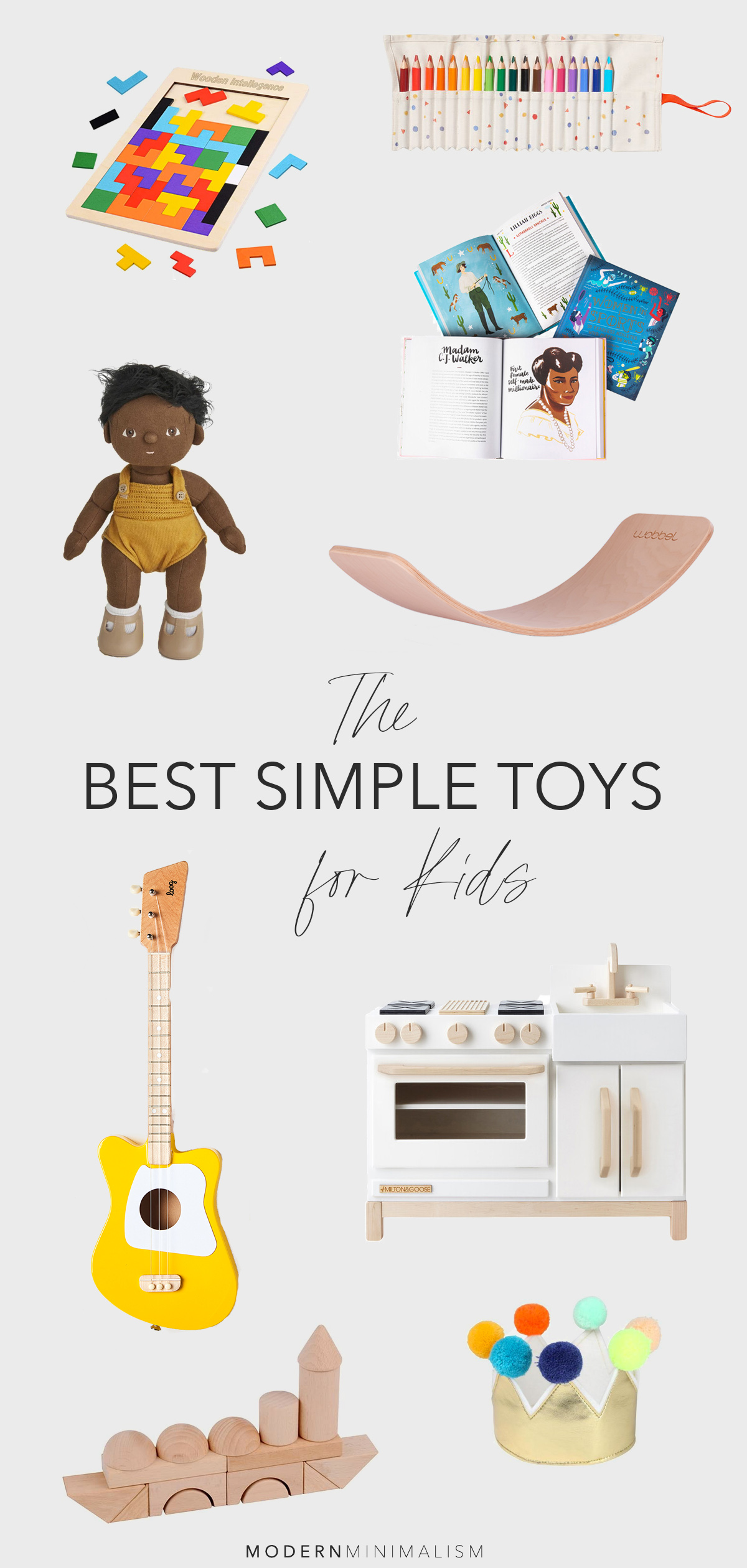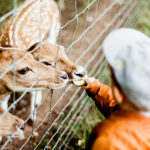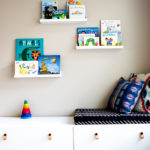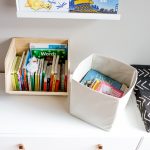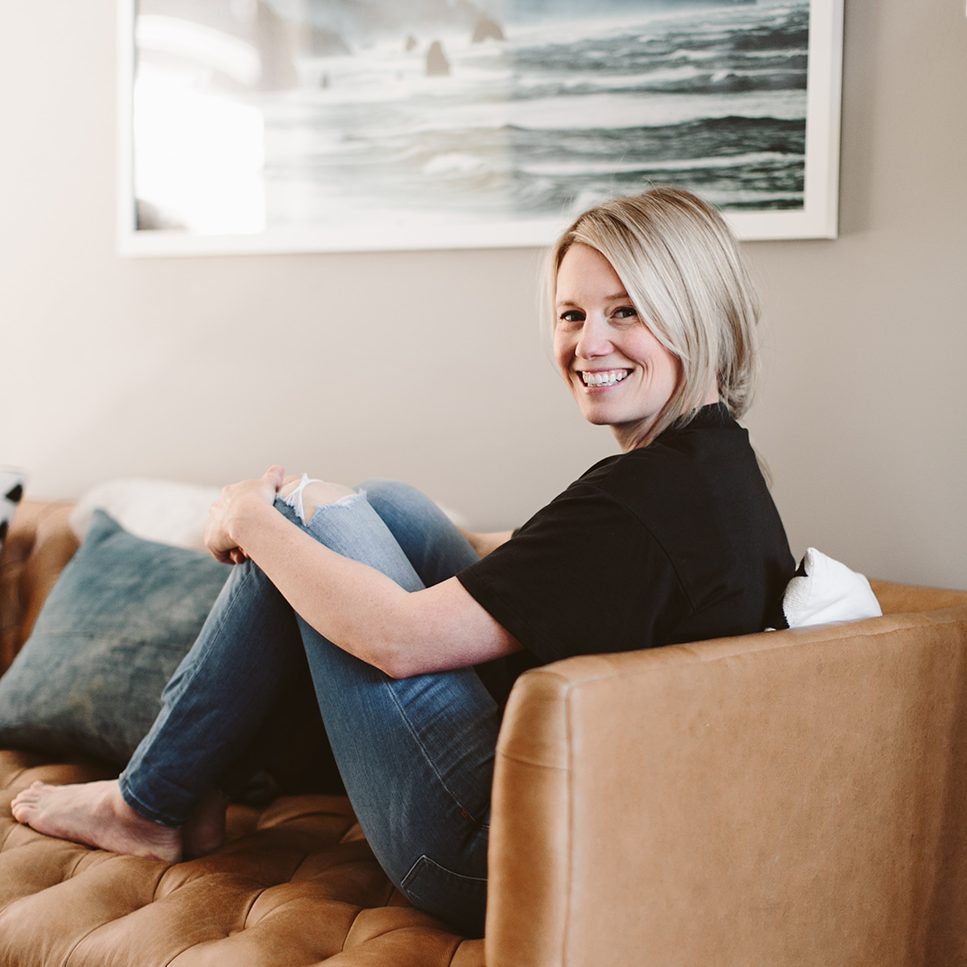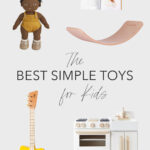Having the right types of toys will help your children to play better, longer, and more creatively with less, and is the key to creating a minimalist toy collection. Here are the 10 best simple toys for kids that will provide provide endless open-ended play opportunities for many happy years.
Simplifying the toys has been a big part of our minimalism journey in the last few years. Along this journey, I’ve gone down many rabbit holes researching the benefits of toy minimalism and the best types of toys for kids. I’ve read studies on how kids play and blogs written by child development experts. I’ve also talked at length with other parents and closely watched how my own kids play.
During this process, I uncovered the secret to toy minimalism: having the right types of toys will allow your children to play better, longer, and more creatively with less.
By having mostly open-ended toys, you will need fewer toys overall. If you’ve not heard of open-ended toys, here’s what you need to know about them and why they’re so great!
Here are the 10 best types of simple toys for kids that will provide endless play opportunities and serve your family for many years to come. Within each category I share why each type of toy is beneficial and some great recommendations.
A note on toy recommendations:
The toys I link to are either toys we own and love or come highly recommended by other parents, child development experts, and educators. While you will find several toy ideas under each category, you do not need every toy listed. You may not even need toys from each category!
1. Active toys
Active toys encourage large movements of the body. Besides burning off energy and developing gross motor skills, research shows that activity is also really good for learning.
The great outdoors is truly #1 when it comes to being active. Let kids get outside where they can run, climb, jump, and balance on whatever surrounds them.
When getting outside isn’t an option, a simple air mattress can provide hours of jumping, climbing, and sliding entertainment. Couch cushions can also be used for obstacle courses and painter’s tape for indoor hopscotch.
This Pikler-inspired climbing structure was a group Christmas gift from family and has been a favorite for a while now. (Amazon also has some nice looking climbing triangles, as well!) We pull this when the weather is really unpleasant, or when the kids have extra energy to burn and getting outside isn’t an option (like while I’m cooking dinner). Our kids have even incorporated it into pretend play, turning the climbing triangle into Captain Hook’s pirate ship and Elsa’s North Mountain.
Some other great gross motor toys include balls, balloons, gym mat, balance beam, mini trampoline, balance boards, stepping stones, scooter boards, a jump rope, and walking cups.



2. Building toys
Building toys like blocks or LEGO, help develop both fine and gross motor skills and creativity.
This category includes various materials, from cardboard boxes to blocks, that can be used to build whatever your kids dream up — castles, parking garages, entire towns, and more.
We constantly play with this simple set of wooden blocks, as well as Magna-Tiles, Classic LEGO, and Mega Bloks, which are safe for little ones and fun to toss in the bath! If you’re looking for an eco-friendly alternative to plastic LEGO, try these bamboo bricks.
A wooden marble run is also lots of fun and will provide older kids hours of entertainment!


3. Pretend play
Pretend play allows kids to experiment with the different social and emotional experiences of life. It enables kids to “walk in someone else’s shoes,” which builds imagination, curiosity, understanding, and empathy.
This category includes things that promote dramatic play: costumes, play houses, kitchens and their accessories, baby dolls, doctor’s kit, and more.
Costumes are great for pretending and can be made from whatever you have around the house. Kids love dressing up in clothes you no longer wear. Old blazers, hats, shoes, purses, and costume jewelry can provide little ones with hours of pretend play.
In addition to costumes, our kids also love their little play kitchen. We recently added a cute shopping cart, some wooden food sets, and a cash register and set up a whole grocery store right in the living room!
Each of our kids also has their own baby doll that they like to care for, take for walks in their doll stroller, and play “house” with.
Some other great pretend toys include a doctor’s kit, play silks, and even an old cell phone.



4. Characters
Characters allow kids to act out social scenes and important themes in their lives.
This category can include Playmobil or LEGO people, stuffed animals, family figures, dolls, puppets, and more.
Keep in mind, because these toys tend to be small and relatively affordable, they can accumulate quickly. It’s easy to fall into the more toys = more play mindset, but research shows the opposite is true. Limit the size of these collections to either a small bin or a certain number.


5. Vehicles
Kids love to reenact the real-life excitement of city scenes, construction sites, airports, and more with miniature trains, planes, cars, and trucks.
Vehicle toys add great pretend play possibilities when paired with favorite characters. Toss some trucks into the sandbox or draw your own set of streets on a big piece of cardboard.
Our little guy loves playing with his firetrucks, LEGO vehicles, and my husband’s Matchbox cars from when he was a kid!


6. Art and craft materials
Art materials are great open-ended toys for all kids, from toddlers to teens. Things like colored pencils, crayons, markers, washable paints, construction paper, cardboard, glue, and glitter can be used to create pretty much anything. Chalkboards, dry-erase boards, and kids easels are great for doodling as well as pretend play, like taking restaurant orders or playing school.
Our oldest, who is now 6, has also been loving these step-by-step drawing books from Usborne, and these natural bath crayons are also a big hit in our house!



7. Sensory toys
Sensory toys like water, sand, slime, playdough, rice, pebbles, beans, and pasta stimulate one or more senses — typically sight, sound, and touch. Some of our kids’ favorites include kinetic sand, playdough, and rainbow beans!
For these kinds of sensory toys, it’s helpful to have a bin or rimmed tray (we love this IKEA table with bin inserts) and a few simple household tools like scoops, measuring cups, a muffin tin, ice cube tray, or wooden playdough tools.
For extra excitement, let your kids give other toys a bubble bath, hide them in sand or beans, or freeze them in ice cubes and dig them out!


8. Puzzles & games
Puzzles are wonderful because they encourage solitary play and foster spatial awareness and problem-solving skills.
We’ve found open-ended puzzles, like this tetris puzzle and pattern blocks, have gotten substantially more use over traditional picture puzzles because they invite problem-solving and can be completed multiple ways.
Games are great for building memory retention, social skills, and strengthening bonds between friends and family members. If you find it difficult to get down on the floor and play with your kids, games are a great way to have fun and deeply engage with them for a short period of time.
Some of our favorite games for littler kids are Zingo, Hi-Ho Cherry-O, Slips and Ladders, and Candyland.


9. Books
Books are included here because they stimulate the imagination, inspire pretend play, and can be enjoyed by kids of various ages. Choose books that everyone enjoys reading together and can be revisited again and again. You can’t go wrong with beautifully illustrated classics and storybook collections.
I personally love storybook collections because they can hold dozens of stories in a single book, saving significant shelf space and reducing visual clutter. Some of our favorite story collections include The Complete Tales of Winnie the Pooh, Richard Scarry’s Best Storybook Ever, Peppa 5-Minute Stories, and the Usborne Illustrated Stories.
Aside from the classics, our kids’ most beloved books at the moment are by Discover Talking Pen. Great for both readers and nonreaders, they’re filled with fun facts that have provided our little ones with hours of educational, screen-free entertainment.


If you’re looking to simplify your book collection, read this post on how we declutter kid’s books. Also, consider borrowing new books from your local library rather than buying them. I find that borrowing before buying helps me decide whether or not it deserves a permanent place in our home — which is rarely the case.
10. Musical instruments
Letting children explore sound and music through musical instruments nurtures self-expression, coordination, builds memory muscles, improves reading, comprehension, and math skills, and promotes movement through dancing. Not only that, making noise is something pretty much every kid loves doing. Am I right?
This instrument collection is a great starter set. Other kid-friendly musical instruments include a xylophone, ukulele, bongo drums, and a microphone. Our kids have also loved many of the musical instruments from B. toys!


Tips for curating a minimalist toy collection
Now that you know the best types of simple toys to have, here are a few tips to help you on your toy minimalism journey.
- Declutter first. Decluttering your toys brings clarity around the types of toys your kids play well with and those they don’t. Decluttering also made me much more aware of the financial and environmental impact of our toy buying behaviors. As a result, decluttering helped us become more conscious and responsible consumers. Here’s everything you need to know about decluttering toys.
- Adopt a “fewer, better” mentality. When possible, invest in a few high-quality, open-ended toys over lots of toys that are inexpensive and of low quality.
- Shop second-hand. Consider buying quality toys second-hand to save money and reduce your consumer footprint. I’ve had great success both buying and selling toys locally on Facebook Marketplace.
- Watch out for overly specific toys. Toys that are very specific or excessively detailed can limit how they are played with. For example, a pretty blue princess dress will be more easily reimagined into Cinderella’s ball gown or a fancy tea party attire than an Elsa costume from the movie Frozen. When you have the option, choose the less specific, more open-ended version of the desired toy.
More toy minimalism articles you might like:
Pin it for later


